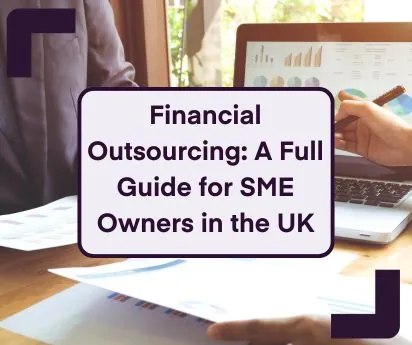
Corporate finance for SMEs
12 Dec 2017Corporate finance isn’t just for big business
If your business is built on solid foundations, you present yourself in the right way with solid financial forecasts and a robust business plan then there will, more than likely, be someone out there who will finance your business.
When people hear the term Corporate Finance there is an immediate misconception that Corporate Finance is only for big business with little or no room for the SMEs that drive the UK economy.
At Accounts & Legal we work with SMEs on a daily basis supporting businesses raise finance who don’t fall into the category of big business and we know there are options out there .What do the experts say businesses are getting wrong?
We have spoken with experts from a range of sources of funding from Bank Managers - who see upwards of 50 new business pitching to them each month - all the way through to new sources challenging the statuesque by facilitating peer-to-peer lending.
We asked one very simple question: why are viable businesses failing to get the funding they need? And this is what we found: Businesses are…
- Applying for the wrong kind of finance: our experts told us that around 50% of the businesses they speak to are applying for the wrong kind of finance. This could be an independent craft brewery applying for a business loan for a new equipment instead of negotiating a Hire Purchase agreement with their supplier. Or a drinks company with a purchase order from one of the major supermarkets looking for a business loan to cover production rather than seeking out supply chain finance. Whatever the specifics of your business it is essential that you find the right type of finance for your specific scenario.
- Asking for too much money: lots of SME’s fail to get the funding they need because they are simply asking for more money than the business, in its current state, can afford. This often happens when a director hears that a lender offers debt up to a specific figure. Say your bank offers a business loan of up to £25k many business owners think “Great I’ll apply for the full amount and use any extra when and where I need it”. This can often result in the stretching or breaking of the metrics used to assess an application. Conrad Ford CEO of Funding Options remarks ‘If the loan amount you’re looking for is more than about a month’s turnover, be careful — because it might lead to an automatic “No”.’
- Insufficient Planning and lack of detailed forecasting: If you can’t answer the question “What is the funding for?” with clarity and details then there is a very high chance that your funding application will be rejected. When making funding applications it is critical that you know not only what the cash will be used for but critically where you expect future cashflows to arise from. If your business plan and financials look like they were drawn up on the back of a napkin then they are unlikely to stand up to scrutiny and will most likely fail. Increasingly lenders are looking to see full financials with forecast financial statements, tracking not only spending and profitability but VAT flows as well.
- Expecting a debt lender to finance an idea: Funding Options’ Conrad Ford notes that ‘looking for established businesses with experienced directors and a track record, not potential’. In other words lenders typically lend to operating business that have a history and can demonstrate an income that will be able to cover debt costs. For individuals with an idea the best place to start is more than likely friends and family, an angle investor or crowd funding.
Types of finance available
If considerable numbers of SMEs are being rejected because they are applying for the wrong type of finance, that doesn’t fit their specific set of circumstances, then what types of finance are available to businesses? There are many different types of finance we will highlight some of the most relevant here:
- Unsecured Business Loan: this is a loan that doesn’t require an underlying asset to act as security (i.e. a property in the case of a mortgage). Instead a lender usually takes a personal guarantee from the directors.
- Asset finance: allows a business to purchase assets and spread the cost of those assets over a period of time. Asset finance comes in multiple forms like Hire Purchase and Equipment leasing.
- Invoice Finance: allows a supplier to receive the payment for outstanding invoices in advance. The lender under these circumstances may take control of the credit control process. Invoice financing in relation to SMEs is typically takes the form of factoring but other options are available.
- Trade Finance: allows businesses to trade internationally and is a form of working capital finance which are designed to bridge gaps in the supply chain (i.e. an exporter exports goods from the UK to the US not receiving payment until the goods arrive). Trade finance typically requires a binding purchase order.
How should you present your business?
Once you have isolated the right type of finance for your particular set of circumstances there are two things that should be done.
Business Plans
A clear business plan laying out the business in its current state of affairs, the application of funds and what the impact the injections of funds will have on the business. The plan need not be complicated but should have the right level of detail in those areas that matter – but it is essential that you clearly illustrate what you will spend the money on.
The areas that matter will change from business to business but might include: details around clients, customers or even specific orders; exploration of why management believes a business will grow at a particular rate and details around spending. As well as the experience and credibility of the management team.
Forecasts
Robust set of forecast financials. Ultimately any application for finance boils down to the figures and whether the business will be able to cover the repayments. Modelling or forecasting the financials not only allows the lender to test a business’s ability to repay the debt but goes further giving then lender confidence in borrower. If a director can provide a Cash flow forecast, P&L and Balance Sheet clearly showing where and how an investment will affect the business. Forecasting will also allow you and your lender to assess whether the amount you are looking for is too much or even not enough to do what it is that you are hoping to achieve. A detailed cash flow analysis will allow your lender to assess whether there is enough head room in your cash flow for the repayment requirements. This is essential for both your credibility and your planning. Talk to us about how we can help with any aspect of corporate finance or business growth issues or problems generally.
























